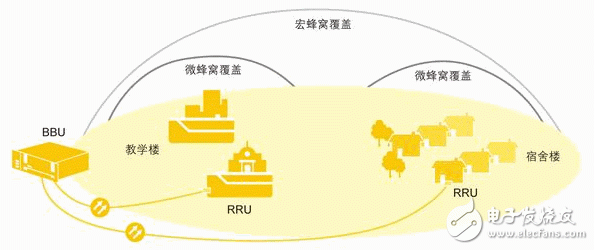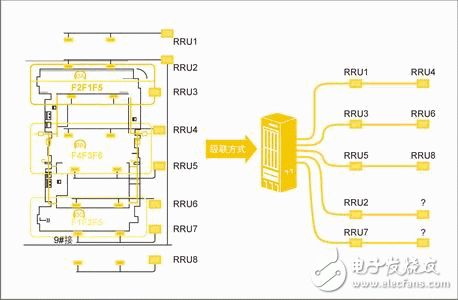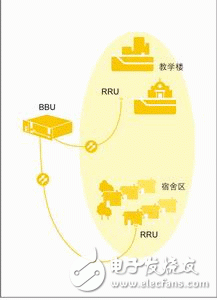With the commercialization and continuous improvement of 3G networks, users are also growing rapidly, and the traffic of high-speed data services has increased dramatically. According to statistics, in the developed first-tier cities in China, 3G data traffic has reached 6-7 times of 2G network traffic. The continuous growth of 3G services requires 3G networks to be further improved to provide better services. As a hot spot, the university campus area is the focus of 3G network construction.
The university campus is a hot spot for 3G services, and it is also a key area for mobile operators to compete for new users and promote new services. The campus campus 3G network must achieve seamless coverage and provide high-speed data download/upload, and high-quality voice services. Based on the experience and technical accumulation of system network planning optimization, ZTE put forward the industry-leading 3G hotspot area coverage solution. From the network planning, fully consider the KPI and user perception of the network, and fully consider the protection operation from the network construction. Business investment and rapid network construction.
Campus area coverage planAccording to the characteristics of 3G network coverage and business needs of the university campus, ZTE proposed the idea of ​​macrocell + microcell combined coverage, as shown in Figure 1.

Figure 1 Macro Cell + Micro Cell Seamless Cover Campus Area
The wide-area coverage of the university campus area can be constructed by using the traditional macro-cellular coverage planning method, using the original 2G site to construct a 3G macro station, and planning the coverage of the university campus area through strict system simulation to realize the macro-cell outdoor open area of ​​the campus. Wide area signal coverage.
The indoor depth coverage of the dormitory area and the teaching building is the focus and difficulty of the university campus area, and can be implemented by multiple micro cells. First consider building an indoor distribution system. However, due to the actual property and engineering difficulties, it is difficult to realize the indoor distribution system in the teaching building and dormitory area in the campus area. Therefore, indoor deep coverage is often achieved by building an outdoor distribution system. From the perspective of cost savings, the existing 2G distribution system should be utilized as much as possible. Evaluate the coverage of 2G systems, the coverage of microcellular systems, and the interference within the system. Through reasonable 2G/3G transformation, fully benefit the old and realize the deep coverage of 3G networks. ZTE uses reasonable means to effectively control inter-cell interference, provide high-quality call services and high-speed data services to meet the high traffic demands of university campuses.
The high-band 3G signal penetration ability is poor. In the conventional coverage mode, there are weak fields in the upper floors of the dormitory buildings, and even cover the blind areas. There is a weak field inside the dormitory building. In order to meet the deep coverage inside the dormitory, the following measures can be taken:
(1) Increase the wall-mounted antenna to solve the signal coverage of the dormitory. The rules for the distribution of buildings in the dormitory area can be installed in the middle of the opposite building to cover the upper and lower floors of the dormitory. It is not recommended to install the antenna on the roof of the building to prevent signal leakage from forming interference.
(2) The RRU is close to the antenna to reduce the feeder loss and increase the antenna transmission power. According to the height and length of the covered building, choose a reasonable antenna lobe angle and replace the antenna with higher gain.
(3) Install antennas in each adjacent dormitory building, and cover the dormitory building on both sides to meet the full coverage of the dormitory.
Coverage and capacity independent planningWith the coverage of the outdoor distribution system, the RRUs of the same building are connected to the same optical port, so that the RRUs of the different buildings are not connected to the same optical port, which facilitates cell division and subsequent capacity expansion. As shown in Figure 2, the number of cells can be flexibly planned according to capacity requirements.

Figure 2 Flexible RRU cascading mode for easy capacity and coverage independent planning
Resource sharing strategy for traffic migrationConsidering the characteristics of pedestrian migration between the dormitory and the teaching building in the campus area, there is also a corresponding migration of traffic. To improve the utilization of system resources, the dormitory building and the teaching building can be merged into the community to realize the sharing of baseband resources, as shown in Figure 3. .

Figure 3 Baseband resource sharing plan for adaptive migration
Frequency and capacity planningThe macro cell and the micro cell are in the same coverage in a certain area, and the macro cell and the micro cell use an inter-frequency network to minimize the interference between the macro and micro cells. Taking the TD-SCDMA system as an example, the frequency planning method is as follows: the macro cell uses a 3-frequency point network. For example, the F7F8F9 network is used, and the micro-cell uses a 6-frequency network. For example, the F1F2F3F4F5F6 network is used, and the F5F6 is fixed to the HSDPA frequency. F1F2F3F4 is multiplexed as the main frequency point 4, R4 service frequency point 2 is multiplexed, and F5F6 is multiplexed as HSDPA frequency point 2.
Taking the TD-SCDMA system as an example, after a lot of actual tests, for a typical dormitory building, two inter-frequency communities can be planned for a single building, and four residential areas can be planned for a large dormitory building. Considering that the campus area is a hotspot area, a 2:4 time slot configuration is adopted. When the system is 75% loaded, the number of R4 service users supported by a single cell is about 450, which satisfies the large capacity requirement. In addition, in order to meet high-speed Internet access and data download, multiple HSDPA carriers can be configured, and ZTE's patented HSPA MX space-speed technology can be used to effectively improve system data throughput.
Campus coverage planning caseThere are 13 teaching buildings in a university campus and 23 podiums in the dormitory area. In order to improve 3G network services, 3G network coverage will be implemented in the student dormitory living area, teaching building, administrative office building and teaching building of the new campus of the university to rapidly expand operations. 3G business.
The existing 2G system in the residential area of ​​the campus area has been simulated and tested on the 3G system signal, providing a reference for coverage planning and simulation on the premise of full profitability. After coverage simulation, based on the original 2G site, three sites are added to meet the continuous coverage of the campus area.
As a traffic-intensive area, the dormitory area can divide a single dormitory into one community, which is divided into 23 communities. The canteen is divided into the same community according to the requirements of traffic migration, and the baseband resources are saved.
The 3G network in the university campus area adopts the idea of ​​macro cell + micro cell combination coverage. The macro cell meets the wide area coverage of the campus area. The micro cell realizes indoor deep coverage, absorbs traffic and meets large capacity requirements.
The macro station is built around the campus area, and the macro and micro cells are combined to achieve the perfect coverage of the campus dense area. According to the characteristics of traffic migration between the dormitory building and the teaching building, the micro cell is rationally planned to save the baseband resources and meet the dense area. Large-capacity demand; using the flexible features of the BBU+RRU networking, the microcells can be merged and split, and the baseband board can be expanded to increase capacity.
Through reasonable planning of campus coverage, 3G coverage indicators and capacity requirements can be met. The implementation of this solution will help build a 3G boutique network and rapidly expand operators' 3G services.
Round Hole Pin Connector,Gold-Plated Round Hole Female Header,Dedicated Round Hole Pin Header,Single Row Round Hole Pin Connector
Shenzhen Jinyicheng Electronci Technology Co.,Ltd. , https://www.jycconnector.com